The post Why Norway Rocks appeared first on The Expeditioner Travel Site.
]]>
I’ve been proudly aware of my Norwegian-ism since my third grade family tree project. Apparently whoever greeted my great-grandfather at Ellis Island was in too much of a hurry to ask the spelling of my last name, so from that point on Jon Wigg has been Jon Wick — which has worked out fine for me.
Where was I going with this? I’m proud of my heritage, but in actuality, I have very little knowledge of my motherland outside of my grandfather’s Christmas tradition of baking a cinnamon bun-like pastry called Stullin. I’ve always felt a pull to visit the country I can’t seem to shake; perhaps nibbling on some lutefisk was the temptation, who knows?
Yes, that dream trip has pervaded my subconscious for some time now, so when I came across The Adventure Journal’s list of reasons why Norway rocks, the dream bubbled over and has resulted in this post (for now).
I don’t need to explain that a mere sixteen reasons why Norway kicks ass just doesn’t cut it. That’s obvious, but to save you a reprimand from the boss, I will condense the list into my top five choices that make me want to get on a plane. And admit it, the TPS Reports can wait.
1. “Allemannsretten” This literally translates to “all man’s rights” but in practice means the “right to access.” You can camp where you want, as long as you’re 150 meters from an inhabited house and you exercise good judgment. Imagine that in America (yeah, right).
2. Norway has 50,000 islands and a coastline that stretches 51,700 miles. Oh, and by the way, as a result of the Gulf Stream, the water is relatively warm.
3. The ski season lasts from October through May. The summer season lasts from June through late September. That means there’s enough time to get your fill of each, no matter what you choose to do.
4. Norway is the cleanest and richest country in the world. And 20 percent of the entire population ski, tele, or snowboard. Yeah, this place has some things figured out.
5. Vikings.
By Jon Wick

About the Author
 Jon lives in Butte, Montana, spending most of his time on skis or bikes; sometimes both. He began travel writing while teaching in Korea and is currently pursuing his Master’s Degree in Technical Communication at Montana Tech. Jon has begun writing his first book, The Story of Will, whose movie rights are still (very) available. Catch more of Jon at TheJonWickproject.wordpress.com. (@ExpedJon)
Jon lives in Butte, Montana, spending most of his time on skis or bikes; sometimes both. He began travel writing while teaching in Korea and is currently pursuing his Master’s Degree in Technical Communication at Montana Tech. Jon has begun writing his first book, The Story of Will, whose movie rights are still (very) available. Catch more of Jon at TheJonWickproject.wordpress.com. (@ExpedJon)
The post Why Norway Rocks appeared first on The Expeditioner Travel Site.
]]>The post On Safari . . . In The North Atlantic? appeared first on The Expeditioner Travel Site.
]]>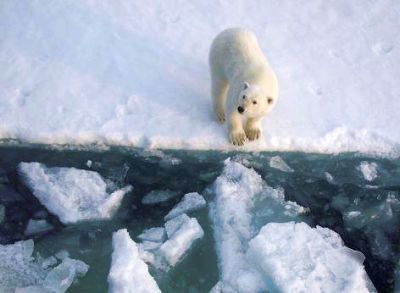
Who says safaris are only for Africa? At the other end of the spectrum — and pole — on an Arctic safari, you can catch glimpses of seals, walruses, and, if you’re lucky, polar bears.
Nobody spoke. At 80 degrees North, the 25-year-old hull creaked in the ice. Camera shutters whirred while expedition staff and passengers stared spellbound. A gargantuan male polar bear stood, flat-footed, only a few feet beneath us on the Norwegian pack ice. Had I leaned just a little further over the ship’s rail, we could have shaken hands. Or rather, I could have lost my video camera and the arm holding it.
It was mid-August. I was aboard the Professor Molchanov on a ten-day trek around Spitsbergen, Norway. The ex-research vessel, crewed by Russians, was my new home away from home. Built for the Hydrometeorology Institute in Murmansk, Russia, it measures a shade over 233 feet long. Ice-strengthened, she was built for Arctic northern conditions.
The remote Norwegian archipelago Svalbard, meaning “Cold Coast,” is home to the world’s most northerly town, Ny Alesund. If you hanker for northern adventures, this is as good as it gets. Here, at the 79th parallel, you are faced with superlatives at every turn: the world’s most northerly post office, earth’s northernmost historical train, the world’s most northerly “tagged” fox family . . . I could go on.
Svalbard’s main island is Spitsbergen, meaning “Pointed Mountains,” and provides the only international airport. On arrival my plane descended around midnight through the low cloud cover into a fairytale setting. Jagged peaks were draped in snow blankets, and the midnight sun pierced through, turning the fjord an apricot hue. From early April to mid-September there is no night here, and from April 19 to August 23, the sun won’t even touch the horizon. The capital settlement of Longyearbyen, housing approximately 1,800 people, is named after John Longyear, one of the Arctic Coal Company’s founders from 1906.
After a restless “night” I headed across town to my ship. I ambled past haphazardly-parked skidoos, abandoned until the winter months. Under a cloudless sky, the mercury hovered at a comparatively balmy 39 degrees Fahrenheit. In town a sign outside the post office politely requested that guns should be left outside, and the pizza vendor advertised his closing time as 5 a.m. I could tell that this trip was going to be a little unusual. And there, moored and shimmering in the fjord — Adventfjorden to be specific — was the imposing hulk, the Professor Molchanov, my ride for the next ten days.
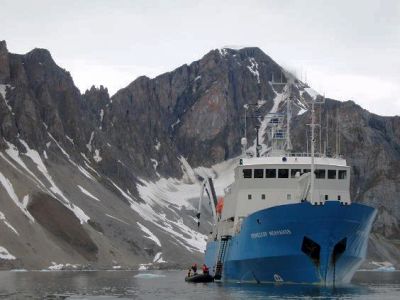 Each morning, at an unsociable hour for a vacation, Troels Jacobsen, our expedition leader, brusquely awakened us in our heavily-curtained cabins. The ship’s speakers would burst into life at 7 a.m. every morning with the unmistakable voice of Jacobsen, authoritatively quoting our longitude, latitude, and the outside temperature, urging us to get immediately out on deck to witness the stunning vistas. We would then glide to an anchoring spot, guzzle down the remains of our coffee from the buffet breakfast downstairs, and climb down and launch out into the sea in our rubber Zodiac inflatable boats.
Each morning, at an unsociable hour for a vacation, Troels Jacobsen, our expedition leader, brusquely awakened us in our heavily-curtained cabins. The ship’s speakers would burst into life at 7 a.m. every morning with the unmistakable voice of Jacobsen, authoritatively quoting our longitude, latitude, and the outside temperature, urging us to get immediately out on deck to witness the stunning vistas. We would then glide to an anchoring spot, guzzle down the remains of our coffee from the buffet breakfast downstairs, and climb down and launch out into the sea in our rubber Zodiac inflatable boats.
The first morning we saw a bearded seal out on an ice chunk, a common sight near glacier fronts. Later, as I was taking pictures of wading Barnacle geese — the islands of the North Atlantic are their main breeding grounds — I caught a glimpse out of the corner of my lens of an arctic fox running along the hillside with a Kittiwake chick in its mouth.
Distracted by the beauty of the glacier Fjortendebreen, we almost missed our first polar bear sighting. He was walking along the shore, close to a beach crowded with seabirds that we’d only just finished visiting. Kittiwakes, Atlantic Puffins, and Purple Sandpipers brought our bird species count to seven for the morning. Not a bad haul.
We then arrived in Ny Alesund, the closest town to the North Pole except for a few military bases. Our group madly rushed to send postcards from the post office, to buy the world’s most northerly socks and hats sporting the words: “79 degrees North,” and to get that important stamp proving we’d set foot here. (There is a rubber stamp in the post office lobby where you can ruin a passport page yourself — and the one facing it — with too much ink.)
A pre-landing brief in the Molchanov’s cosy bar brought home the very real danger bears can pose to humans. Jacobsen toted a rifle as he spoke. There were three rifles in all, one for each expedition staff member. “Always be within 100 feet of a gun on land, and no more than 20 people to each gun,” he explained seriously. Despite smiling while we drank tea attentively, this was no joking matter. “I really, really, don’t want to shoot a bear,” stressed Jacobsen for the umpteenth time. He was adamant that he would never allow a situation to develop where killing a bear was an option.
If a bear happened to be roaming on an island that we planned to explore, we would have to alter our itinerary so as to avoid any dangerous encounters. This happened one day, but a little too late — we were already on the island. A guide spotted a lumbering splodge about a mile away on the opposite shore, steadily heading in our direction. We quickly moved back to our landing site for a swift evacuation back to the ship, then recounted later that night, over a stiff drink, how we’d almost been eaten.
Bear-wise, the highlight came on day six, as we were floating just beneath the 80th parallel. Jacobsen’s scheduled lecture on the “ice bear” — as the Europeans call it — rapidly dissipated when the real thing was spotted from the bridge. I will never fathom how our Russian captain can see a white bear — a mile away, no less — in an icy seascape of an eye-crossingly similar color. But he did, and seemingly right on cue.
The bear emerged from a little ice nook and approached curiously, but not cautiously. After sniffing the hull, jumping back just briefly when a plane flew low overhead, he wandered around to the ship’s stern. Poorly dressed passengers — some had hurried outside wearing only slippers and bathrobes — were turning a bluish color by now, but nobody wanted to go inside. This was extraordinary and spectacular; our guides were shaking their heads with incredulity, quite clearly amazed.
We lay heaped on top of each other, hanging over the rail, as the bear seemed to make eye contact. He raised himself onto his hind legs, standing at least eight feet tall. Barely two yards beneath me now, I could see the striations in his claws and the individual hairs in his fur. The ice compacting under his paws was the only sound as we collectively held our breath. I gazed into his dark eyes, pools of gleaming inquisitiveness, until he quietly retreated into the pristine icy wilderness.
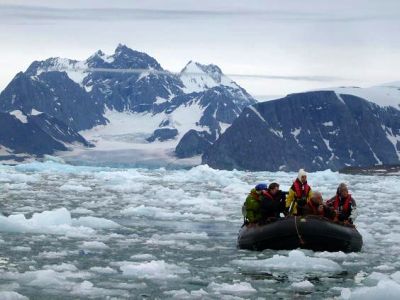 Unbelievably, that same evening, just before midnight, the ship’s intercom crackled with another sighting: a mother with a cub this time. We shivered under a weak sun as the duo plodded over the bluish ice ridges, leaping from floe to floe. We watched, mesmerized, as the cub miscalculated the jumps, plunging its plump rump into the freezing water off the starboard side. It remained unfazed — the thick insulation of blubber means that polar bears can endure temperatures down to minus 40 degrees Fahrenheit without increasing their metabolic rate.
Unbelievably, that same evening, just before midnight, the ship’s intercom crackled with another sighting: a mother with a cub this time. We shivered under a weak sun as the duo plodded over the bluish ice ridges, leaping from floe to floe. We watched, mesmerized, as the cub miscalculated the jumps, plunging its plump rump into the freezing water off the starboard side. It remained unfazed — the thick insulation of blubber means that polar bears can endure temperatures down to minus 40 degrees Fahrenheit without increasing their metabolic rate.
Having reached our most northerly point of 80’ 32” it was all downhill now. Well, south anyway. Though with flatulent walruses, Russian trappers’ huts, and calving glaciers still to visit — to name just a few points of interest — the trip was far from over.
On our second-to-last evening, as we cruised deep in the fjord system of Hornsund, Jacobsen radioed all five Zodiacs to cut their engines. We floated, silent, simply appreciating the swishing and popping of the glacial ice surrounding us. We were in the High Arctic, at the top of the world, and I didn’t want to leave. This northern realm of the world’s largest carnivore had me under its spell. Then the silence was shattered as the engines revved back up, awakening me from a dream I never wanted to forget.

The post On Safari . . . In The North Atlantic? appeared first on The Expeditioner Travel Site.
]]>The post Experiencing Norway’s Winter Sports And Living To Tell About It (Barely) appeared first on The Expeditioner Travel Site.
]]>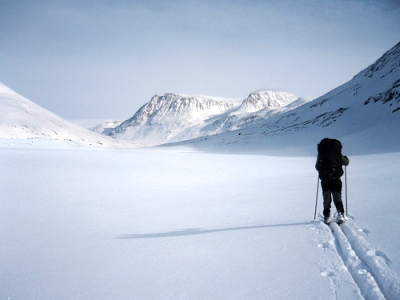
What do you get when you mix dog sledding, .22 rifles, and Norway’s most famous liquor? How about an unforgettable weekend experiencing the best of Norway’s winter sports.
Emerging onto a 3,000-foot plateau in central Norway, the moment freezes. To the east, hundreds of miles of virgin tracks glide enticingly away through the countless conifers of Rondane National Park; to the west, the Scandinavian sun melts over the darkening domes of the Jotunheimen range, its last watery rays hinting at the promise of adventure through drifting clusters of snowflakes. The snow tires of the minibus spin on the icy road, and I can’t wait to get out there. True, I’ve never tried cross-country skiing before, but putting one foot in front of the other can’t be that hard, can it? Before this trip is over, I will rue my overconfidence.
For now, though, a welcome hot drink by a log fire awaits back at the hotel. It’s there we meet our hosts and instructors for the next few days: Nick, a languidly composed former Infantry officer and highly qualified ski instructor; Tony, a clipped and courteous ex-Royal Marines officer; and Pat, a serious mountain man even by the admission of his hugely experienced colleagues. Between them they total nearly a century of military service, not to mention expertise in teaching leadership and organizing expeditions to such forbidding places as Antarctica, South Georgia and Everest. Nordic Challenge, the company formed by Nick and Tony in 2003, aims to give guests of all shapes, sizes and ages the distilled benefit of this vast know-how.
In the morning, after a buffet breakfast worth coming for in itself, there are chores to be tackled before we can hit the tracks. First it’s necessary to select the right clothes: light layers of absorbent and breathable fabrics, followed by just the right kind of ski wax for the conditions. All that’s needed then is a pair of slipper-like boots that click into the skinny skis at the toe only, allowing the heels to lift and making it possible to ski uphill as well as down. Fully equipped, we’re ready to kick out into the wild whiteness.
At first the going is good. All we’re asked to do is slot our skis into inches-deep railtracks carved by a snowplow, and shuffle forwards. Then Nick informs us that we haven’t actually started yet. The trick to this kind of skiing is to “jog” along, keeping the center of gravity low, flinging out the sticks to the rear, and transferring your weight squarely from foot to foot and letting the skis slide. It’s a lot to remember, and getting the knack entails much flailing around like a tortoise on its back, not to mention a conscious effort to ignore apple-cheeked Norwegian children swishing past with innate poise. When the timing comes together, though, the sense of oneness with the Christmas-card surroundings is as thrillingly clear as the Nordic air.
Before long, the effort needed to keep the skis parallel leaves me puffing. Thickening snowfall is filling in the tracks and the spray of powder is swirling on the breeze. It’s time to flop, with cheeks burning, in a ridiculously cozy log cabin complete with open fire, and get to know the seven other members of my group. One of them, an “author and eccentric” called Sue, turns out to be a retired policewoman-turned-shepherdess living a hardy, isolated life in the North of England; another, Andrew, is a rugby player hoping not to fall on his oft-injured shoulder. Then there’s Vena, a budding novelist and keen swimmer (who’s already done 30 lengths of the hotel pool early that morning), and Claire, a sociable specialist in strategic marketing and self-styled couch potato; she definitely wasn’t in the pool at dawn.
Whether it’s the tingling mountain air, or the superbly sugary hot chocolate and waffles, everyone’s on a rarefied high and ready for anything — which is just as well, for with military precision, our hosts are outlining some optional activities for us to sample. The first of these, dog sledding, involves yoking together half a dozen raring-to-run Alaskan huskies, stepping up onto the back runners of your sled, hoisting the ice anchor and whisking off in convoy around a circular course. I quickly master the rubber footplate that curbs the dogs’ progress (or so I think) and soon I’m nurturing fantasies of triumphant Polar expeditions, even as we round a tight turn and my 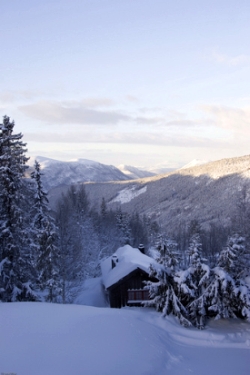 stabilizing leg sinks up to the waist, capsizing the sled and tipping out my passenger, the unfortunate Claire, head-first. For a few long minutes we’re in deep snow, so to speak, with the dogs still surging ahead and Claire buried upside down. I feel a bit ungallant about leaving her like that, but the golden rule, we were told, is to “never let go of the sledge.”
stabilizing leg sinks up to the waist, capsizing the sled and tipping out my passenger, the unfortunate Claire, head-first. For a few long minutes we’re in deep snow, so to speak, with the dogs still surging ahead and Claire buried upside down. I feel a bit ungallant about leaving her like that, but the golden rule, we were told, is to “never let go of the sledge.”
An hour later, having scrabbled out of our powdery predicament, we’re standing at the top of a worryingly sheer tobogganing track. Claire has seen an early chance for retribution: this time, I’m going to be the passenger. The young hut attendant squeezes go-karting helmets onto our heads and shows us the steering bar and the brake, neither of which seem to interest Claire much. In the 42 breathless seconds that follow, we veer across the sheet ice, accelerating all the time, and into rougher regions off the main track. There’s a shriek as we hit something under the surface (a rock, a root, a hapless reindeer?), the sledge stops dead and I continue the descent by air, executing a double somersault as pure as the drift in which I come to a crumpled halt. We count the cost — my knee, her ribs — and, for the second time in as many hours, chastened yet helpless with exhaustion and laughter, start digging ourselves out of an embarrassing mess. This time without the help of huskies.
Later we realize how much worse our tumble might have been, and that this kind of environment must be treated with more respect than we’ve shown it so far. We’re not the only ones to have picked up minor knocks — Sue’s colorful elbow draws admiring murmurs back at base — so we resolve to act more responsibly. Bumps and bruises notwithstanding, though, I know I haven’t had so much fun in one day since I was three.
Next day, we’re split into two biathlon teams — Shackleton and Scott. As John, a professional photographer, astutely points out, both groups seem destined for glorious failure: one missed its goal and survived, the other reached it and perished. We’re shown how to use the weighty .22 rifles, which have a range of one kilometer, and asked to take five pot-shots at five tiny targets while still out of breath from completing a ski circuit. Scott edges the contest, but again at a price: Andrew falls on his bad shoulder, makes a “you guys go on without me” speech, and plods back towards the hot chocolate hut in the manner of Captain Oates.
Over dinner, the consensus is that none of us has lived life this intensely for some time, and a few are already speaking of plans for next year. After all, Norway has unanswerable advantages as a winter sport destination: boundless miles of pristine scenery, a season that lasts until May, the chance to ski the length of the country in hut-to-hut stages and full-on, no-mobile-signal wilderness for the serious adventurer.
The week winds up with a taste-of-Norway trip to Lauvåsen (by minibus for most; only two of the group are deemed capable of covering the 10 kilometers on skis without doing themselves an injury). It’s here we encounter Norway’s answer to the après-ski excess of the Alps: good company by the fireside and linie aquavit, a flavored spirit distilled from potatoes. We’re talked through aquavit etiquette, which consists of holding the glass to your chest, inhaling the aroma, taking a sip and making eye contact with your neighbor — a social custom that only consolidates the bonds that have developed between us in a short time. True to the pattern of the week, I overdo things again, recklessly knocking back shots that have no effect at all until I hit the freshest air in the world, with predictable consequences. By the time I get home, I’m still wondering if it was all a dream. Of course it was.

About the Author
 Carl Thompson has been writing for travel publications and guidebooks for many years, mainly with the intention of avoiding a proper job. For the full story of a misspent decade, please visit UKTravelWriter.co.uk.
Carl Thompson has been writing for travel publications and guidebooks for many years, mainly with the intention of avoiding a proper job. For the full story of a misspent decade, please visit UKTravelWriter.co.uk.
The post Experiencing Norway’s Winter Sports And Living To Tell About It (Barely) appeared first on The Expeditioner Travel Site.
]]>The post Sweden’s First National Marine Park appeared first on The Expeditioner Travel Site.
]]>
Let’s be honest, what’s not to love about Sweden? The place that gave us the infamous bikini team, has now designated its first National Marine park, just so they could have a place to frolic. Well, a guy can dream, right?
Kosterhavet National Marine Park is found in the Koster Islands, between Sweden and Norway, and the most westerly inhabited islands in Sweden. You can reach the park by boat from Strömstad, Sweden (pictured above).
The Guardian offers up an in-depth view on the park, discovering its nearly stress free lifestyle, and even better activities. From scuba diving, to hiking, sea kayaking, and crayfish safaris, the almost carless islands offer just about anything an outdoorist could imagine. Long standing as nature reserves, the islands got bolstered into national park status due to the over 6,000 different marine species calling it home.
The post Sweden’s First National Marine Park appeared first on The Expeditioner Travel Site.
]]>The post It’s A Small World After All . . . In Oslo? appeared first on The Expeditioner Travel Site.
]]>
For a truly authentic Norwegian experience, head to the country during the May 17th celebrations. But be prepared, you may never think of Norway the same way again.
By Catherine Skrzypinski
“Hei, I am Øivynd,” the shy Norwegian greeted me and my classmate, Zarinah, in front of the Royal Palace in Oslo, Norway.
It sounded like he said the word “even.”
He gestured towards his friend wearing a bunad, Norway’s national costume. “This is my friend Odd.”
I stifled a giggle. Even and Odd — now that’s quite the pair. They’re Norway’s very own Chip and Dale, decked out in red jackets and white knee-high socks.
“Welcome to Norge. Especially on the 17th of May,” he said enthusiastically. “It’s a great day to be here in Oslo!”
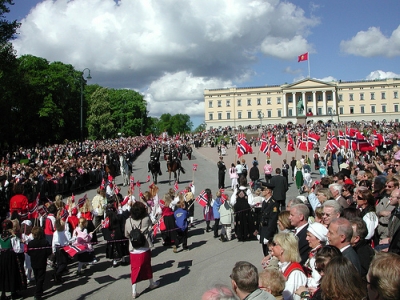 Indeed it was. May 17th is Norway’s Constitution Day, an annual celebration that marks the day in 1814 when Norway adopted its constitution and gained independence from Denmark, and is one of Norway’s most popular holidays. It is so popular, in fact, that many Danes travel across fjords and back through time to witness the spectacle.
Indeed it was. May 17th is Norway’s Constitution Day, an annual celebration that marks the day in 1814 when Norway adopted its constitution and gained independence from Denmark, and is one of Norway’s most popular holidays. It is so popular, in fact, that many Danes travel across fjords and back through time to witness the spectacle.
The May 17th celebrations were my first impression of the peaceful, ruggedly beautiful country I would later call home for a brief while. While I was living in Aarhus, Denmark, for graduate school, my classmates and I were granted a five-day weekend to travel to Norway in order to experience the May 17th pomp and pageantry firsthand.
Zarinah and I pooled together our pathetic student funds on a ferry ticket, booked a hostel, and boarded the booze cruise from Denmark to Oslo, Norway’s capital city. Crossing the North Sea, the ship navigated through the snow-capped fjords while the music of Grieg faintly serenaded us in the background. Alas, I was slightly hungover from the oil swill I drank the night before, but I was in awe of the dense forests filled with massive fir trees and numerous Norwegian flags dotting the landscape.
Finding accommodations during this festive weekend was difficult, but we thought we scored the deal of a lifetime at a hostel on the outskirts of Oslo. One step inside proved otherwise.
Twenty rickety Ikea beds were hastily placed in front a huge blackboard. “Welcome to Norway’s National Day!” was scribbled in red and blue chalk above the beds.
“Where in the world are we?” Zarinah stared at me, in disbelief.
“We’re crashing at Schoolhouse Rock!” I cheekily responded.
Eager to escape yet another classroom, Zarinah and I aimlessly wandered around downtown Oslo. We quickly discovered that springtime in Scandinavia can be quite a trippy place. Daylight lasts beyond 11 p.m., so most of the city was taking full advantage of the extended sunshine by swigging down many pints of Ringnes at Aker Brygge, Oslo’s newly rejuvenated waterfront area. We stopped for our own pint in a bar located in Grunerlokka, Oslo’s grungy, Greenwich Village-ish enclave. On every street corner the Narvesens, a one-stop shop for polser (hot dogs) and train tickets, practically outnumbered the Norwegians.
 As we cruised on a tram at twilight (around 11:45 p.m.), Vigeland Park peered out at us. Created by Gustav Vigeland, Norway’s best known sculptor, Vigeland Park’s sculptures depict “man’s journey from cradle to grave, through happiness and grief, through fantasy, hope and wishes of eternity.” Inside Vigeland Park, I found a kindred spirit in the Angry Baby (Sinnataggen, which roughly translates to “The Hothead”), the statue of a young boy crying and stamping his feet. The statue is virtually a part of Norway’s national heritage, akin to Copenhagen’s “The Little Mermaid.”
As we cruised on a tram at twilight (around 11:45 p.m.), Vigeland Park peered out at us. Created by Gustav Vigeland, Norway’s best known sculptor, Vigeland Park’s sculptures depict “man’s journey from cradle to grave, through happiness and grief, through fantasy, hope and wishes of eternity.” Inside Vigeland Park, I found a kindred spirit in the Angry Baby (Sinnataggen, which roughly translates to “The Hothead”), the statue of a young boy crying and stamping his feet. The statue is virtually a part of Norway’s national heritage, akin to Copenhagen’s “The Little Mermaid.”
This country doesn’t feel like the real world, I thought to myself as I stared out into Frogner Park at dusk. In my mind, the “real world” was chaotic New York, with its dirty streets, noisy people and crowded spaces. Norway was the antithesis of my reality. For the most part, Oslo’s public spaces were as silent as a library. When I heard the faint chatter of Norwegian, it was soothing and comforting, even though I could barely understand a word. The streets were immaculately clean — not a drop of rubbish in sight. Had I found Utopia in Norway?
That’s when it hit me. I hate to say it, but Oslo felt like a strange version of Disneyland.
“Oslo’s a fantastic city,” I commented to Zarinah, deliberately omitting the Disneyland reference because she hails from another Disney-esque country, Singapore. “I can see myself living here for a while.”
What foreshadowing! Little did I know I’d soon be living in Oslo myself.
Only six hours later, the sun was up, and the Norwegians, including our newfound friends Øivynd and Odd, had donned their bunads for the day’s celebrations. We all gathered along Karl Johans Gade, Oslo’s main street, for the annual children’s parade.
Compared to Aarhus, Norway felt very diverse and multicultural. While there were many parade-goers decked out in their bunads, as is customary during this holiday, there were also Norwegian women adorned in saris, African dress, and Vietnamese “Áo Dài.” Yes, it was a national holiday, but May 17th also celebrates the many ethnic groups that now comprise Norway, including Pakistanis, Somalis and Vietnamese. It was eerily reminiscent of Disney’s very own “It’s A Small World” musical tour of nations. Everyone gathered around the Royal Palace, eagerly awaiting the appearance of the Norwegian royal family on the balcony. In Norway, celebrating patriotism is infectious.
“A-ha!” I remarked after spotting Prince Haakon, inadvertently alluding to one of Norway’s most famous exports. No, not oil, or lutefisk, but a-ha, the ’80s pop superstars that captivated the world with “Take on Me.”
After the brass bands finished playing the Norwegian national anthem — no, not “Take on Me” but “Ja, vi elsker dette landet” (Yes, We Love This Country) — a large group of “russ” (Norwegian teens on the verge of graduation) noisily barreled down the street in their red frocks. It was now time for lunch.
You would think that most Norwegians would commemorate their Constitution Day with a smorgasbord of salmon and Jarlsberg cheese, right? Not so much. Norwegian tykes are rewarded for all their hard work marching in the parade with ice cream, candy and hot dogs. Meanwhile, Øivynd and Odd placed napkins over their bunads as they devoured Big Macs and McDonald’s French fries in front of the Stortinget, Oslo’s parliament building.
Later in the evening, we all gazed up at the Norwegian sky for a spectacular fireworks display. For a split second, I felt like I was in Anaheim, enchanted by the pyrotechnics in the distance, while being charmed by the kindness of the Norwegians surrounding me. That proved it to me. Oslo was in fact a surreal, improved twist on Disneyland, after all.

The post It’s A Small World After All . . . In Oslo? appeared first on The Expeditioner Travel Site.
]]>